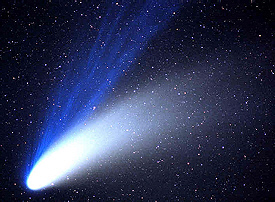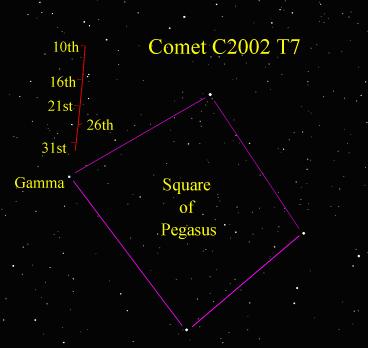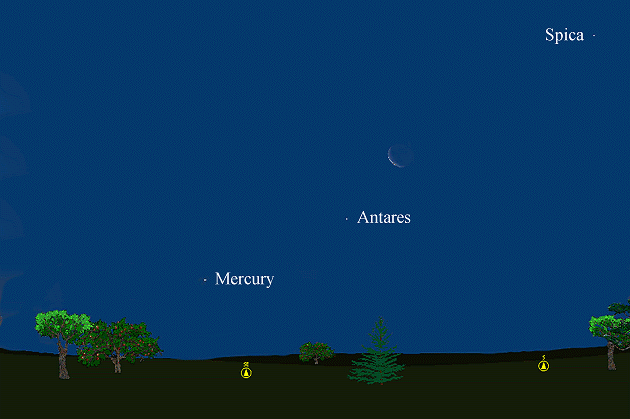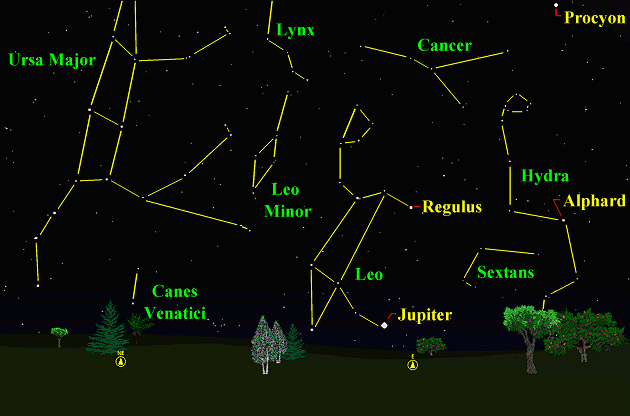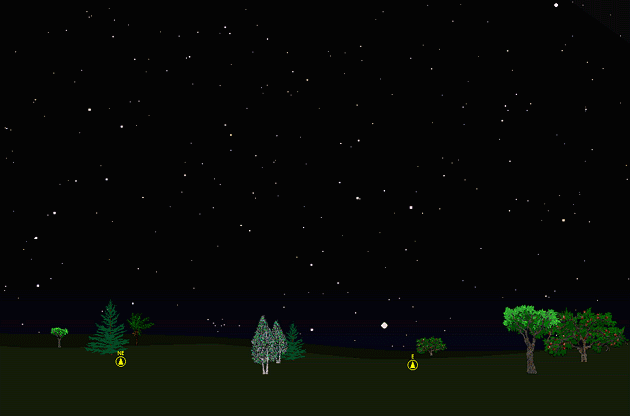The purpose of this new feature is to give scout leaders, educators and naturalists an idea of some of the natural events coming up each month. We will try to cover a variety of natural events ranging from sky events to calling periods of amphibians, bird and mammal watching tips, prominent wildflowers and anything else that comes to mind. We will also note prominent constellations appearing over the eastern horizon at mid-evening each month for our area for those who would like to learn the constellations. If you have suggestions for other types of natural information you would like to see added to this calendar, let us know! Note: You can click on the hyperlinks to learn more about some of the featured items. To return to the Calendar, hit the "back" button on your browser, NOT the "back" button on the web page. Sky Events: Evening Sky: Venus is dazzling in the twilight sky after sunset this month. Bright Jupiter joins Saturn in the evening sky, rising a little after 9:00pm at mid-month. Both planets are much brighter than the stars surrounding them, and both look a little larger than stars in 8x binoculars. The four "Galilean" moons of Jupiter are also sometimes visible in binoculars, provided you brace your arms against something steady. Mars, fading fast, is high above and to the left of Venus. See the diagram below. The apparent size of Mars has been steadily shrinking in telescopic views, and the planet's disc is now only about 7.6 seconds of an arc in diameter. It's fun to spot it with the naked eye after seeing the views from the Mars Rover, however. The second Mars Rover is scheduled to touch down on the evening of January 24th. If you would like to follow the live feed from JPL Mission Control you can do so at, http://www.nasa.gov/multimedia/nasatv/ . We had a great time listening to the first rover landing live on January 3rd. Although we have a fairly slow telephone modem, the real time audio from mission control came through fine, and the video feed came through in still frames about every two seconds.
An Approaching Comet:
" Like a breeching whale before it plunges to the ocean depths, a comet briefly luxuriates in the sunlight and then is gone." Carl Sagan and Ann Druyan, Comet. Comet C2002 T7, discovered on October 4th, 2002, may put on a show this spring. Although it's hard to predict exactly how bright a comet will become, this one could be a naked eye comet. You can use binoculars to get a glimpse of the approaching comet while it is still far away from the sun by scanning near the "Square of Pegasus." You will need a dark country sky and a moonless night to see it this way, and it will just be a small faint glow. As shown in the left figure below, first find Venus about 6:45pm. Spread the fingers on one hand as far as you can and hold your hand at arm's length. Look for the "Square of Pegasus" about two spread hand's widths above Venus . Use Mars to check your position. As shown in the right figure below, there is a line of faint stars extending upward from Gamma Pegasus that are easily visible in binoculars. Look along this line at the positions and dates shown for the comet.
Morning Sky: Mercury reaches greatest elongation from the sun on January 17th, and you may want to try to glimpse the elusive planet low in the morning sky before sunrise. Mercury and the waning crescent moon form a pretty grouping with the stars Antares and Spica on the morning of the 17th, as shown below. Try around 6:30am. A flat southwestern horizon will make viewing easier.
All times noted in the Sky Events are for Franklin, Tennessee and are Central Standard Time. These times should be pretty close anywhere in the mid-state area. Constellations: The views below show the sky looking east at 9:30pm CST on January 15th. The first view shows the sky with the constellation outlines and names depicted. Star and planet names are in yellow. Constellation names are in green. The second view shows the same scene without labels. The planet Jupiter dominates the eastern sky in terms of brightness, but gets no respect from Leo, the Lion, who appears to have his rear paw resting on the giant planet this month. The too-long tail of Ursa Major, the Great Bear, has now cleared the horizon and Hydra, the Water Serpent, rears its head menacingly. Its brightest star Alphard is known as "The Solitary One" because of its somewhat isolated location from other bright stars. Canes Venatici, the Hunting Dogs, also make their appearance. Among the fainter constellations visible in the east are Leo Minor, the Small Lion, Cancer, the Crab, and Sextans, the Sextant.
On Learning the Constellations: We advise learning a few constellations each month, and then following them through the seasons. Once you associate a particular constellation coming over the eastern horizon at a certain time of year, you may start thinking about it like an old friend, looking forward to its arrival each season. The stars in the evening scene above, for instance, will always be in the same place relative to the horizon at the same time and date each January. Of course, the planets do move slowly through the constellations, but with practice you will learn to identify them from their appearance. In particular, learn the brightest stars (Like Regulus and Procyon in the scene looking east), for they will guide you to the fainter stars. Once you can locate the more prominent constellations, you can "branch out" to other constellations around them. It may take you a little while to get a sense of scale, to translate what you see on the computer screen or what you see on the page of a book to what you see in the sky. Look for patterns, like the stars of the "Big Dipper." The earth's rotation causes the constellations to appear to move across the sky just as the sun and the moon appear to do. If you go outside earlier than the time shown on the charts, the constellations will be lower to the eastern horizon. If you observe later, they will have climbed higher. As each season progresses, the earth's motion around the sun causes the constellations to appear a little farther towards the west each night for any given time of night. If you want to see where the constellations in the above figures will be on February 15th at 9:00pm CST, you can stay up till 11:00pm CST on the January 15th and get a preview. The westward motion of the constellations is equivalent to two hours per month. For instance, if you want to see what stars will be on your eastern horizon on April 15th at 9:00pm CST (3 months later), you would need to get up at 3:00am CST in the morning on January 15th (3 months times 2 hours/month = 6 hours). A good book to learn the constellations is H. A. Rey's
classic, The Stars, A New Way to See Them. Rey's depictions of the
constellations and witty commentary are terrific. A good general reference book on astronomy is the Peterson
Field Guide, A Field Guide to the Stars and Planets, by Pasachoff.
The book retails for around $14.00. A good beginners software program for learning the night sky
is the Starry Night Beginner program. Visit the Starry Night web site at
www.starrynight.com The program retails for around $30.00 and
contains a wealth of information.
Circumzenithal Arcs: Fall, Winter and Spring are good times to watch for these beautiful arcs that form directly overhead. Be sure to look upward in the late afternoon anytime you have wispy cirrus clouds in sky.
Amphibians:
Contrary to popular belief, a lot of things happen with amphibians in January. To see them, though, you have to be out in the sort of weather that makes most (sane) people stay indoors. The trick is to go out on mild (50 degrees Fahrenheit or warmer) rainy nights. For safety, it is important that you have another person with you to watch for traffic as you slowly drive the back roads, looking for things that cross the road in front of you and frequently stopping and listening. Upland Chorus Frogs, who can have breeding choruses as early as December, are calling more frequently now. In January, calling Spring Peepers become more common (they have been observed calling every month in Tennessee). Wood Frogs have their short-lived breeding choruses in woodland ponds, where they are often joined by Spotted Salamanders. Tiger Salamanders also breed in January in less wooded areas and the eggs of both can often be found this time of year. For photos of common winter egg masses, click here. Southern Leopard Frogs are also sometimes calling on mild January nights. We have seen Northern Cricket Frogs, Green Frogs, Bullfrogs and American Toads foraging in January. And just about anything is possible. On January 22, 1999, we found a Eastern Spadefoot out in the stormy weather. That same day a tornado ripped through Clarksville, Tennessee, doing much damage to the Austin Peay campus. January is an exciting time of year to look for herps!
Birds: If you walk grassy fields that have some wetter areas, you may flush a Short-Eared Owl, a winter resident in Tennessee. We have flushed them from fields at Pardue’s Pond near Ashland City, along the roads that go to Pace Point near Big Sandy, Tennessee, at Britton Ford near Dover, Tennessee and at Savannah Bottoms, south of Savannah, Tennessee. These birds tend to occupy the same habitat as Northern Harriers, so if you see Harriers over grassy fields, be on the lookout for the owls. They often begin flying in the late afternoon, coursing over the fields like a Harrier. It’s a good idea to check any “Northern Harrier” you see in the late afternoon to make sure it’s not a Short-eared Owl. Now is also the time to walk pine and cedar thickets to look for rare owls like Long-eared Owls and Northern Saw-whet Owls. You probably have already put out your bird feeders, but if you haven’t you're missing out on a lot of good looks at winter feeder birds. This is a great time of year to start learning your birds. Watch and listen for winter residents such as White-throated and White-crowned Sparrows, Yellow-bellied Sapsuckers, Red-breasted Nuthatches, Golden-crowned Kinglets and Brown Creepers. Recommended: Bird Finding in Tennessee, Michael Lee Bierly. A classic guide to finding birds in Tennessee. The Sibley Guide to Birds, David Allen Sibley The Sibley Guide to Birds of Eastern North America, David Allen Sibley This new Sibley Guide covers only eastern North America, is quite compact, and is less expensive than the larger Sibley. An inexpensive guide for beginners is the Golden Guide for Birds. Archives (Remember to use the back button on your browser, NOT the back button on the web page!)
Natural Calendar
December 2003
Natural Calendar
November 2003
Natural Calendar
September 2003
Natural Calendar
February 2003
Natural Calendar
December 2002
Natural Calendar
November 2002 Nature Notes Archives: Nature Notes was a page we published in 2001 and 2002 containing our observations about everything from the northern lights display of November 2001 to frog and salamander egg masses. Night scenes prepared with Starry Night Pro software All photographs Ó2004 LEAPS
|
